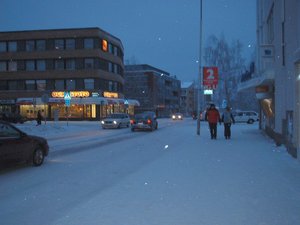Rovaniemi
|
|
| Missing image Rovaniemi_vaakuna.png Rovaniemi coat of arms | |
| City | Rovaniemi (1960) |
| Administrative Province | Province of Lapland |
| Historical Province | Laponia |
| Area - Total - Land - Water | Ranked Xth 100 km² 94.3 km² 6.6 km² |
| Population - Total (2003) - Density | Ranked 20th 35,110 2824/km² |
| Missing image Finnish_map_with_Rovaniem_highlighted.png | |
Rovaniemi (Roavenjarga in Northern Sami) is the administrative capital and the centre of commerce of Finland's northernmost Province, Lapland. It is situated close to the Arctic Circle and between the hills of Ounasvaara and Korkalovaara, at the confluence of the Kemijoki River and its tributary, the Ounasjoki River. Due to its advantageous location it is the starting point of the Great Arctic Highway. The city is completely surrounded by Rovaniemen maalaiskunta (Rural municipality of Rovaniemi). The two municipalities will be joined into one on January 1, 2006. and the new municipality will have an area of 7 900 km² and an approximate population of 60 000.
The word Rovaniemi has often been considered to be of Lappish origin, as "roavve" in Sami denotes a forested ridge or hill or the site of an old forest fire. In the dialects of southern Lapland, however, "rova" means a heap of stones, a rock or a group of rocks in a stretch of rapids, or even a sauna stove.
| Contents |
History
There has probably been continuous settlement in the Rovaniemi area since the Stone Age. Periodic clearance of new land for agriculture and the practice of slash-and-burn cultivation began around 750-530 B.C. Artifacts found in the area suggest that an increasing number of travellers from Karelia in the east, Häme in the south and the Arctic Ocean coast in the north must have come there from 500 A.D. onwards. The Sami are considered to be Lapland's own indigenous population.
The exploitation of Lapland's natural resources in the 1800s boosted Rovaniemi's growth. Extensive logging sites and gold fever attracted thousands of people to Lapland. As the mining of natural resources was increased, Rovaniemi became the business centre of the Province of Lapland.
In the Lapland War, during the Second World War, approximately 90% of the total property in the town was destroyed by German troops. The rebuilding of Rovaniemi began in 1946. Several public and private buildings designed by the Finnish architect Alvar Aalto have been erected in the town. One example is the Administrative and Cultural Centre, which comprises the City Hall, the Lappia Hall (housing the City Theatre, Orchestra and Congress Hall), and the Provincial Library.
Rovaniemi Today
Christmas_celebration_in_Rovaniemi.jpg
Because of the unspoilt nature and numerous recreational opportunities, tourism is an important industry in Rovaniemi. The city has a number of hotels and restaurants located both in the centre and on the outskirts of the town. The majority of its 35,000 inhabitants make their living in service professions.
Since Rovaniemi represents the capital of the Province of Lapland, many government institutions have their offices there. It is said that out of 35,000 inhabitants, about 10,000 are students. Rovaniemi is home to not only the University of Lapland but also the Rovaniemi Polytechnic, which comprises institutes of information and traditional technology, business, health and social care, culinary studies, forestry, rural studies and sports.
Rovaniemi's most prominent landmarks include the Jätkänkynttilä bridge with its eternal flame over the Kemijoki river, the Arktikum House which rises out of the bank of the Ounasjoki river, the Rovaniemi Town Hall, the Lappia House which serves as a theatre, concert hall and congress centre, and the library. The last three mentioned buildings are by the famous Finnish architect Alvar Aalto. The residence of Santa Claus, Santapark (http://www.santaclausoffice.fi), is located outside the city in Rovaniemen maalaiskunta. Rovaniemi is also home to the world's northenmost branch of McDonald's.
A phenomenon also attracting numerous tourists is the Aurora Borealis or Northern Lights. In Finnish Lapland the number of auroral displays can be as high as 200 a year whereas in southern Finland the number is usually fewer than 20.
Facts and Figures
Climate
- average temperature: + 0.2 °C
- annual rainfall: 535 mm/annum
- snow stays on the grounds 183 days a year on average
- lowest temperature ever recorded: - 45.3°C
- highest temperature ever recorded: + 30.6°C
- the midnight sun can be seen from June 6th to July 7th
Population
(figures 2000/2001)
- female: 18,524
- male: 16,406
- Finnish: 35,158
- foreigners: 497
- total: 34,930
Employment
(figures 1999)
- primary production: 1.6 %
- manufacturing in industry: 14.9 %
- private services: 36.8 %
- public services: 44.4 %
- unknown: 2.3 %
Famous Figures
The popular Finnish author Jari Tervo is a native of Rovaniemi and his novels describe the town in an unforgettable manner.
Snowboarder and 2005 Winter X Games gold medalist Antti Autti is a Rovaniemi native, and in April 2005 he received his own piece of land in the city for being named to the 2006 Finnish Olympic team.
External links and references
- http://www.fintravel.fi - Online travel information Finland and incoming tour operator
- http://www.laplandfinland.com - Information about Finnish Lapland
- http://www.rovaniemi.fi - Rovaniemi's official website
- http://www.ulapland.fi - Website of the University of Lapland
- Rikkinen, K. A Geography of Finland. Lahti: University of Helsinki (1992)
- Rovaniemi: Arctic Circle - Finland. Helsinki: Oy Sevenprint Ltd (1998)de:Rovaniemi
et:Rovaniemi es:Rovaniemi fr:Rovaniemi pl:Rovaniemi pt:Rovaniemi ro:Rovaniemi se:Roavvenjárga fi:Rovaniemi sv:Rovaniemi

